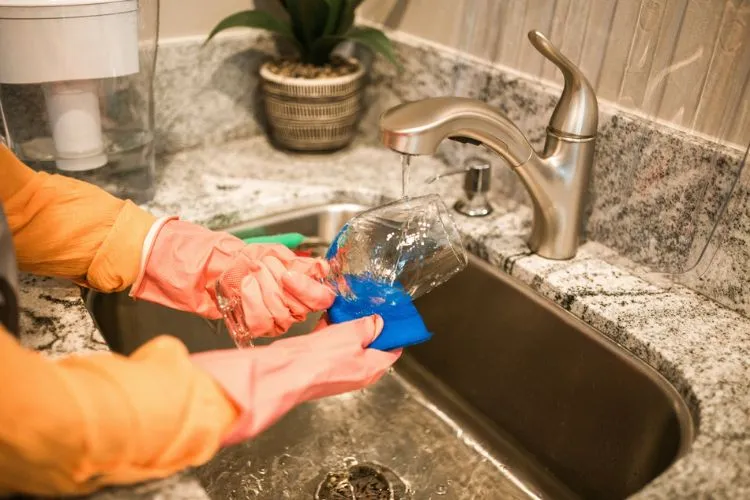When installing a water softener in your home, it may not immediately occur to you to think about where the backwash, the flushed waste water from the system, should be discarded.
However, disposing of water softener backwash is an essential aspect of maintaining a water softening system – not just for the environment’s sake, but also to comply with local regulations.
This article aims to guide you through where can you discharge water softener backwash.

💦 Legal and Environmental Considerations
Before discharge, one must review local regulations. Around the world, there may be varied legal stipulations for handling saline wastewater due to its potential to contaminate freshwater resources. Penalties can be imposed for non-compliance, which can be as severe as heavy fines.
On the environmental side, high salinity can lead to soil degradation, alter the osmotic balance of water bodies, and harm aquatic life by causing an increase in water hardness which affects organisms’ metabolic processes.
💦 Where Can You Discharge Water Softener Backwash?
Determining the best method for disposing of water softener backwash will depend on your local sewage regulations, the design of your plumbing system, and environmentally sound options available.

Direct Discharge to Ground
Some homeowners may consider discharging their backwash directly onto the ground as a seemingly simple solution. Yet, this can lead to the accumulation of salt in the soil which can inhibit plant growth and leach into groundwater.
Disposal into Municipal Sewage
Pouring the backwash into the sanitary sewer is commonly practiced and accepted in many municipalities, as treatment plants are usually equipped to handle such waste. Nevertheless, homeowners should confirm with local wastewater authorities to avoid any contravention of municipal regulations.
Integration into Septic Systems
For homes with septic systems, caution is advised. Septic systems are designed for biological waste, so adding high volumes of saline liquid can disrupt the delicate balance, impairing the system’s function and possibly leading to system failure. It’s wise to consult a septic system professional before choosing this option.
💦 Best Practices for Water Softener Backwash Disposal
To ensure you’re doing your part to dispose of backwash ecologically and legally, it’s wise to adopt several best practices.
First, verify the local codes and regulations in your area concerning backwash discharge. If municipal discharge is permitted, make sure your home’s infrastructure is linked to the public sewer properly.

If you are considering discharging to a septic system, it’s vital to prevent potential harm with regular maintenance and monitoring by professionals. Most importantly, try to minimize the volume of backwash by using a water softener efficiently sized to your household’s needs.
The Implications of Improper Discharge
The stakes of inappropriate disposal of water softener backwash are high. Aside from the potential environmental degradation, including the destruction of natural habitats, there are practical concerns for the homeowner as well.
Incurring the wrath of environmental protection agencies can lead to expensive fines. Moreover, improper disposal can harm your own property’s landscaping and soil health.
💦 Advanced Water Softener Technology
The landscape of water softening technology has seen significant advancements aimed at reducing or even eliminating the need for backwash, offering a more sustainable and environmentally friendly approach to managing hard water.
Among these innovations, template-assisted crystallization (TAC) and electrical ion exchange stand out for their efficiency and minimal environmental impact.
Template-assisted crystallization, or TAC, is a technology that transforms dissolved hard minerals in water into harmless, microscopic crystals. Unlike traditional ion exchange water softeners that require salt and generate backwash, TAC systems operate without any chemicals or salt.
This process prevents scale without the need for backwashing, as the crystals simply flow through the plumbing system without attaching to surfaces.
Electrical ion exchange, another groundbreaking technology, uses electricity to remove minerals from water, replacing the conventional resin beads and salt.
By altering the electrical charge of ions, this method effectively prevents scaling. The system is compact, easy to maintain, and significantly reduces water waste because it doesn’t rely on flushing out trapped minerals.
These advanced water softening solutions represent a significant leap forward in reducing the environmental footprint of water softening.
By adopting such technologies, homeowners can enjoy the benefits of soft water without the concerns associated with backwash disposal, making these options an excellent choice for those seeking sustainable home water treatment solutions.
You may also find useful: Does Water Softener Reduce TDS?
💦 Frequently Asked Questions (FAQs)
Is it legal to discharge water softener backwash on the ground?
While it might be legal in some places with proper precautions, it’s generally advised against due to the risks of soil and water contamination.
How does water softener backwash affect a septic system?
Backwash can disrupt the bacterial processes in a septic system, potentially leading to failures and costly repairs.
Are there eco-friendly alternatives for disposing of water softener backwash?
Yes, one can consider water softeners that utilize potassium chloride, which is less harmful to the environment, or look into newer, more eco-conscious models that minimize waste.
Conclusion:
It’s clear that the disposal of water softener backwash should not be taken lightly. The choice of where and how to dispose of this waste requires careful consideration of both environmental implications and legal guidelines.
By understanding your options and the consequences of each, you can make an informed decision that aligns with environmental stewardship and regulation compliance.

Devon Shorts, a seasoned expert with over a decade of experience in water safety, shares valuable insights on this blog “Aqua Safety Plus”. Trust his expertise to keep your water clean and your family safe.
